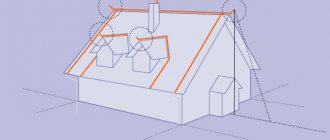According to current legislation, each building and room must be assigned an explosion hazard category, depending on the substances stored in it, the number of personnel, number of floors, wall materials and other factors. Classification of fire and explosion hazards is carried out on the basis of clear standards and legislation, by persons who have undergone special training and have a certificate. The further organization of fire safety at the facility, peace of mind during inspections by regulatory authorities and the lives of people in the event of a fire depend on the correct assignment of the class.
Regulatory documents for classification
In order to clearly determine which category certain premises and buildings belong to, two methods and documents regulating them have been developed. The deterministic method in the Russian Federation is regulated by NPB-105-03 and the “Rules for the construction of electrical installations” (PUE). The classification of explosive zones according to PUE and NPB-105-03 helps to divide production and warehouse buildings, as well as technical blocks into categories, which indicates subsequent planning or development by number of floors (in case of facility expansion), choice of materials and other equipment. The probabilistic method is formulated in GOST 12.1.004-91 and implies taking into account the acceptable risk, the probability of a fire and the totality of hazardous factors in each specific room.
Normative base
The need to classify categories of buildings and facilities for fire safety is stated in Law No. 123-FZ of July 22, 2008 “Technical Regulations on Fire Safety Requirements.” On its basis, Code of Rules No. 2.13130.2009 dated 01.05.2009 “Definition of categories of premises, buildings and outdoor installations for explosion and fire hazards”, as well as Fire Safety Standards NPB 105-03, were developed.
To determine the class, use the method from NPB 105-03. This is done at the stage of developing design estimates and operational documentation for the facility. In total, there are 5 categories of fires for buildings. security. They are designated by Russian letters from A to D and are grouped by risk reduction. For rooms of groups 8: A, B, B1-B4, D, D.
Categories of premises
Based on the deterministic method, all premises are divided into categories from A to D, which indicates the risk of fire or explosion in them. The detailed classification looks like this:
| Category | Characteristics, features of the room |
| A - considered the most explosive, with a high probability | It is characterized by the content of flammable gases, substances and liquids that can ignite at room temperatures up to 28 degrees. The vapor explosion has an overpressure of 5 kPa. Materials stored in the room can catch fire from contact with water or room air (oxygen in it). |
| B - fire and explosion hazardous | Materials similar to category A, liquids (emitting vapors) and gaseous substances that can lead to easy ignition and explosion, but at temperatures above 28 degrees. |
| B1-B4 - fire hazardous | Category B is assigned to premises where solid materials, liquids, fibers are stored, which, when in contact with air, water or each other, are capable of self-ignition, but without causing an explosion. Dividing the category from 1 to 4 specifies the specific fire load in MJ/m2, varying from 1-180 (B4) to 2200 (B1). |
| G - moderate fire hazard | Areas in which liquids, solids and gases are burned as fuel. Working with non-flammable raw materials and objects if they, when heated, are capable of emitting sparks, fire or radiant heat, which can lead to the ignition of finishing materials, etc. |
| D - reduced fire hazard | This includes rooms in which the materials are completely non-flammable if they are in a cold state. |
The category of a room or building according to HPO and software affects:
- Selection of structures during the construction of a building (or its reconstruction) with a certain fire resistance limit
- The need for a smoke removal system
- The need for fire compartments and fire barriers
- The need for fire extinguishing systems
- Explosion protection of electrical installations. Based on the category of the room, zones for electrical installations are calculated (explosive and fire hazardous)
- The need for fire protection and fire arresting valves in the existing ventilation system
- The need for organizational measures, for example, competent organization of the technological process, in order to eliminate the risk of a man-made disaster or fire as a result of a spill of flammable liquids.
All of the above points ensure the safety of people and property. Also, all these points are reflected in the final price of construction or reconstruction of any building.
It is also necessary to understand that the calculation is made based on the actual characteristics of the room and the technological processes occurring in it, and is not something immutable. In the event of a radical change in the fire load in the room (the amount of materials capable of burning), as well as the height and area of its placement, it is necessary to recalculate.
To determine, or more precisely, to calculate the category of a room in terms of explosion and fire hazard (HE), you need to know the following parameters: the geometric dimensions of the room, the amount of flammable substances and materials, as well as the height and area of their placement. As a rule, this calculation is made on the basis of technical specifications agreed with the owner of the premises. It is influenced not only by the amount of flammable substances, but also at what height to the ceiling they are placed, as well as the material from which the ceiling or ceiling is made (wood or concrete).
| In addition, the class of zones is determined according to the Rules for the Installation of Electrical Installations (PUE). Simply put, explosive (B-I, B-Ia, B-Ib, B-Id, B-II, B-IIa) and fire hazardous (P-I, P-II, P-IIa, P-III) zones are identified . For such areas, installation of explosion-proof technological equipment is required (for example, the electrical circuit of such equipment must be intrinsically safe and (or) the equipment must have an explosion-proof housing, etc.) |
Building categories
Explosion hazard classes of premises affect the category to which the entire building can be classified. Depending on the area of rooms with hazardous substances and their quantity, the following assessment is given to the entire property:
- A - assigned if the area of individual premises is 5% or more of the entire building, provided that it does not have automatic fire extinguishing systems. When they exist, such a class is awarded if there are 25% or more m2 falling under category A. Another criterion is the total space of such rooms from 200 m2 in the first case and from 1000 m2 in the second.
- B - this class is assigned when the total area of premises with categories A and B exceeds 5% (without automatic extinguishing systems) and 25% with automatic installations. The same standards for total area limits apply here as in category A.
- B - the area of premises of categories A, B, C exceeds 5% (or 10%, if only A and B). If there are automatic extinguishing systems, it is assigned when 3500 m2 is exceeded.
- D - the sum of the area of rooms with categories A, B, C and D more than 5%. If the building has a built-in automatic fire extinguishing system, then the number is considered to be 25% m2 of the total or 5000 m2 in total.
- D - all other buildings not included in categories A, B, C, D.
Classification of premises by degree of danger
Electrical safety is the main condition that must be observed when operating electrical installations, regardless of whether we are talking about residential, office or industrial premises. The risk of being harmed by electric current is present wherever there is operating electrical equipment; it can be minimized by a set of protective measures, including grounding, but there are rooms where the risk of electric shock is much higher.
Damage to electrical safety is caused by various factors that are present to one degree or another in industrial and other premises. For example, the likelihood of suffering from an electric shock in a room with a dry wooden floor is much lower than in a room where the floor is grounded. Of course, in different conditions the requirements for electrical safety will differ, which is why a classification of premises according to the degree of danger has been introduced.
Factors determining increased danger
Electricity itself is dangerous; in addition to threats to human health and even life, it carries a high fire hazard; this largely depends on the conditions in which electrical equipment must be operated. Thus, production workshops or non-production premises are characterized by an increased risk of injury, where the following factors occur:
- the presence of conductive dust in the air;
- high relative air humidity – more than 75%;
- operation of electrical equipment in conditions of elevated air temperature – above 35°C;
- the presence of grounded conductive floor coverings or earthen floors;
- the likelihood of simultaneous contact with live parts and grounded metal structures during maintenance of electrical installations.
The mentioned factors contribute to an increase in air conductivity, negatively affect the insulation of electrical equipment, and the last two pose a direct threat of injury to humans.
Classification
Taking into account the danger posed by the above harmful factors, the rules for operating electrical installations in the current 7th edition define the following classification (clause 1.1.13 of the PUE). According to the degree of danger, all premises are divided into 3 categories:
- without increased danger;
- with increased danger;
- especially dangerous.
The premises of the first category include dry premises with normal climatic conditions, in which any of the above factors are absent. This characteristic may correspond, for example, to a warehouse.
Premises where one of the above factors is present are at increased risk. Most industrial premises can be classified as this type, ranging from “hot” metallurgical workshops to cozy electronics assembly shops with a special microclimate, for which a conductive floor is a necessary condition for combating static electricity.
A characteristic feature of a particularly dangerous category of premises is extremely high dampness; particularly damp premises are those where the air humidity approaches 100%, accompanied by the appearance of condensation. At the same time, this type of premises is characterized by the presence of aggressive or organic environments that pose a threat to the insulation and live parts of electrical equipment. Another characteristic of premises of particular danger is the simultaneous presence of at least two of the above factors, and the installation sites of existing electrical equipment in open space are also equated to them.
Still have questions?
Fill out the feedback form below, our specialists will contact you, advise you, and tell you about possible ways to solve your problem.
order a consultation
The need for classification by attitude
Since electrical equipment is used in most premises in enterprises, the degree of spread of the fire and the difficulty of extinguishing it depend on the strength of its housing and frame. For example, a machine that uses oil for lubrication can still burn for a long time, although there is only metal around it. In this regard, they developed “Rules for the Construction of Electrical Installations” (PUE), regulating the level of protection of equipment used depending on the explosion hazard class of industrial premises.
Another standard here is GOST R 51330.9-99, which evaluates the quantitative influence of various factors on the area (presence of explosive mixtures, ventilation, current, frequency of presence of hazardous substances in a particular place). Depending on this, 1st class or 2nd class is awarded. The degree of probable leakage, its duration and interaction with surrounding materials are also taken into account. Class 3 is not used in the system, but is replaced by more expanded divisions (classes 20, 21, 22).
2.2.2 Classification of hazardous areas according to TR on TPB (Article 19)
Terms and definitions used for WHO classification according to TR on TPB
An explosive atmosphere is a mixture with air, under atmospheric conditions, of flammable substances in the form of gas, steam, dust, fibers or volatile particles, in which, after ignition, self-sustaining flame propagation occurs (GOST R IEC 60079-0-2007).
An explosive gas environment is a mixture with air, under atmospheric conditions, of flammable substances in the form of gas or vapor, in which, after ignition, self-sustaining flame propagation occurs (GOST R IEC 60079-0-2007).
Explosive dust environment is a mixture with air, under atmospheric conditions, of flammable substances in the form of dust or volatile particles, in which, after ignition, self-sustaining flame propagation occurs (GOST R IEC 60079-0-2007).
A fire hazardous (explosive) zone is a part of a closed or open space within which flammable substances are constantly or periodically circulating and in which they can be located during the normal operation of the technological process or its disruption (clause 30, article 2 of the TR on industrial safety regulations) .
Classification of zones according to PUE
The explosion hazard class according to the PUE helps to select the correct level of equipment protection, which reduces the overall likelihood of a fire or explosion. It is assigned based on the following characteristics:
- 0—equipment operates continuously or for more than an hour using explosive gas.
- Class 1 - also designated as BI, the installations operate as usual and emit their own flammable gases or technical liquids that can spontaneously ignite from the air.
- Class 2 - prescribed as B-Ia, and refers to areas where the release of explosive substances is possible only in the event of equipment breakdown or accident. It may have clarifying classes B-Ib - gases with a flammability limit of 15% or higher, which have a pungent odor for detecting leaks (ammonia, etc.). B-Ig - zones inside which there are oil films and other flammable liquids in an open form (filling and draining oils, oil traps, settling tanks). The size of the zone extends up to 20 m from the place where the flammable liquid is open.
- Class 20 - constant presence of substances with a lower flammability limit of 65 g/m3 and below.
- Class 21 - designated as B-II. Release of flammable vapors and liquids during equipment operation, with a concentration of 65 g/m3.
- Class 22 - also found as B-IIa. Formation of an explosive cloud with a concentration limit of 65 g/m3 by working units as a result of an accident.
The classification of fire and explosion hazardous areas, and the specific explosion hazard class in each case is taken into account when designing systems for preventing fires, warning personnel, organizing evacuation and equipping places with extinguishing means. TRIO is an expert in this field, and we are ready to survey any property and help assign the correct class to each room, building and area. All work is accompanied by documentation ensuring the passage of inspections by regulatory authorities. We provide a full range of services to ensure fire safety at the facility.
Determining the class of the premises area
Sign “Category Class of premises”
Zone P-IIa is suitable for most premises
Classification of fire hazardous areas (according to Federal Law-123 and PUE)
Fire hazardous areas are divided into the following classes:
1) P-I - zones located in rooms in which flammable liquids with a flash point of 61 degrees Celsius or more are circulated;
2) P-II - zones located in rooms in which flammable dusts or fibers are emitted;
3) P-IIa - zones located in rooms in which solid flammable substances circulate in quantities at which the specific fire load is at least 1 megajoule per square meter;
4) P-III - zones located outside buildings and structures in which flammable liquids with a flash point of 61 degrees Celsius or more or any solid flammable substances circulate.
Classification of hazardous areas (according to Federal Law-123)
Depending on the frequency and duration of the presence of an explosive mixture, hazardous areas are divided into the following classes:
Class 0 - areas in which an explosive mixture of gases or liquid vapors with air is present constantly or at least for one hour;
Class 1 - areas in which, during normal operation of the equipment, flammable gases or vapors of flammable liquids are released, forming explosive mixtures with air;
Class 2 - areas in which, during normal operation of the equipment, explosive mixtures of gases or liquid vapors with air are not formed, but the formation of such an explosive mixture of gases or liquid vapors with air is possible only as a result of an accident or damage to the process equipment;
Class 20 - zones in which explosive mixtures of combustible dust with air have a lower flammable concentration limit of less than 65 grams per cubic meter and are constantly present;
Class 21 - zones located in rooms in which, during normal operation of the equipment, combustible dusts or fibers that become suspended and are capable of forming explosive mixtures with air at a concentration of 65 grams or less per cubic meter are released;
Class 22 - zones located in rooms in which, during normal operation of the equipment, explosive mixtures of flammable dusts or fibers with air are not formed at a concentration of 65 or less grams per cubic meter, but the formation of such an explosive mixture of flammable dusts or fibers with air is possible only as a result of an accident or damage to technological equipment.
Methods for determining the classification indicators of an explosive zone are established by fire safety regulations.
Classification of hazardous areas (according to PUE):
Class B-I zones are zones located in rooms in which flammable gases or vapors of flammable liquids are emitted in such quantities and with such properties that they can form explosive mixtures with air under normal operating conditions, for example when loading or unloading technological equipment, storage or transfusion of flammable liquids in open containers, etc.
Class B-Ia zones are zones located in premises in which, during normal operation, explosive mixtures of flammable gases (regardless of the lower concentration limit of ignition) or flammable liquid vapors with air are not formed, but are possible only as a result of accidents or malfunctions.
Class B-Ib zones are zones located in premises in which, during normal operation, explosive mixtures of flammable gases or flammable liquid vapors with air are not formed, but are possible only as a result of accidents or malfunctions and which are distinguished by one of the following features:
1. Combustible gases in these areas have a high lower concentration limit of ignition (15% or more) and a pungent odor at maximum permissible concentrations according to GOST 12.1.005-76 (for example, machine rooms of ammonia compressor and refrigeration absorption units).
2. Premises of production facilities associated with the circulation of hydrogen gas, in which, according to the conditions of the technological process, the formation of an explosive mixture in a volume exceeding 5% of the free volume of the room is excluded, have an explosive zone only in the upper part of the room. The explosive zone is conventionally taken from 0.75 of the total height of the room, counting from the floor level, but not above the crane runway, if any (for example, water electrolysis rooms, charging stations for traction and stater batteries).
Paragraph 2 does not apply to electrical machine rooms with hydrogen-cooled turbogenerators, provided that the electric machine room is provided with natural exhaust ventilation; these electrical machine rooms have a normal environment.
Class B-Ib also includes areas of laboratory and other premises in which flammable gases and flammable liquids are present in small quantities insufficient to create an explosive mixture in a volume exceeding 5% of the free volume of the room, and in which work with flammable gases and flammable liquids is carried out without use of open flame. These areas are not considered explosive if work with flammable gases and flammable liquids is carried out in fume hoods or under exhaust hoods.
Class B-Ig zones - spaces near external installations: technological installations containing flammable gases or flammable liquids (with the exception of external ammonia compressor installations, the choice of electrical equipment for which is made in accordance with 7.3.64
) above-ground and underground tanks with flammable liquids or flammable gases (gas holders), racks for draining and loading flammable liquids, open oil traps, settling ponds with a floating oil film, etc.
Zones of class B-Ig also include: spaces near openings behind the external enclosing structures of premises with explosive zones of classes B-I, B-Ia and B-II (with the exception of window openings filled with glass blocks); spaces near external enclosing structures, if they contain devices for exhausting air from exhaust ventilation systems of rooms with explosive zones of any class or if they are located within an external explosive zone; spaces near safety and breathing valves of containers and technological devices with flammable gases and flammable liquids.
Class B-II zones are zones located in premises in which flammable dusts or fibers that become suspended are emitted in such quantities and with such properties that they are capable of forming explosive mixtures with air under normal operating conditions (for example, during loading and unloading technological devices).
Class B-IIa zones —
zones located in premises in which the hazardous conditions specified in
7.3.45
do not occur during normal operation, but are possible only as a result of accidents or malfunctions.
Zones in premises and areas of outdoor installations within up to 5 m horizontally and vertically from the apparatus in which explosive mixtures are present or may occur, but the technological process is carried out using open fire, hot parts, or the technological apparatus has surfaces heated to the self-ignition temperature of flammable substances gases, flammable liquid vapors, combustible dusts or fibers are not classified as explosive in terms of their electrical equipment. The classification of indoor environments or outdoor environments outside the specified 5-meter zone should be determined depending on the technological processes used in this environment.
Indoor areas and outdoor areas in which solid, liquid and gaseous flammable substances are burned as fuel or disposed of by combustion are not considered explosive in terms of their electrical equipment.








